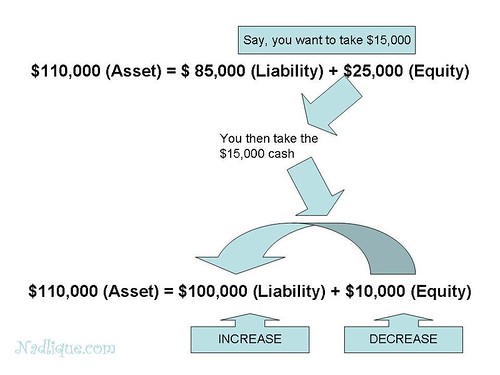Alright, let’s talk about the concepts of Asset, Liability, Equity.
We start off with this accounting formula:
Asset = Liability + Equity
To give these terms simple definitions:
Asset: What you control
Liability: How much of that control is not actually yours (yet…)
Equity: How much of that control is yours
Let’s have a look at this example here:
You bought a house worth $100,000 and paid a 10% down payment for it ($10,000). The rest of the amount is financed by a bank.
So, here’s the situation:
The $100,000 house = Your ASSET (You control this)
The $90,000 loan = Your LIABILITY (Proportion of the bank’s loan)
The $10,000 down payment = Your EQUITY (Proportion of what is actually yours)
That’s also why, when you calculate your net worth, if you have a 1-million-dollar house in your portfolio, sometimes, it doesn’t mean that you are worth $1,000,000. If your equity is only $200,000 and the other $800,000 is from the bank’s loan, that means your net worth is only $200,000.
Let’s have a look at another concept related to investment properties. The concept is “locked up equity in investment properties.”
Generally, the price of houses increase over time. Going back to the first example of the $100,000 house, let’s assume this:
1. The price of the house has increased by 10% after one year
2. The amount of loan paid after one year is $5,000
So,
ASSET = $110,000 (after an increase of 10%)
LIABILITY = $85,000 (minus the $5,000 paid)
EQUITY = $10,000(down payment) + $5,000(loan paid off) + $10,000(increase of house price)
As you can see here, your equity has increased from $10,000 to $25,000. That $25,000 is locked up with the house. You can’t withdraw it easily like cash from your savings account, thus why it is called locked up equity. One way to ‘release’ this equity, so to speak, is by refinancing the property.
What is that you ask? Basically, you tell the bank of the new amount of equity in your house (through proper procedure of course), and the bank transfers the amount you require from EQUITY to LIABILITY, and now you can withdraw that money. Of course, this will add to your LIABILITY section and decrease your EQUITY section. In other words, you are borrowing more money from the bank and use that NEW EQUITY as a collateral.
Have a look at the diagram below:

Why would people refinance then? Well, normally, people do that so that they can use that “locked up” money to purchase other investment properties. Then, the following year, as the price of that first house and the newly-purchased house increase, more EQUITY will be available. Now, they might want to withdraw that further EQUITY and purchase more properties.
In a way, it’s like rearing goats. You first buy father goat and mother goat. Then they procreate, thus producing baby goats. These baby goats grow up, then father goat and mother goat procreate again, and baby goats also procreate, producing more goats. You get the picture.
In this case, you’re trying to breed properties.
Alright, till next post.
P.S. This post is not a specific advice or recommendation to do anything. Consult your financial advisers before investing your money. Refer to my DISCLAIMER.
Go to HOME
Go to SITEMAP
Go to DISCLAIMER